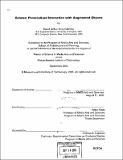Galatea : personalized interaction with augmented objects
Author(s)
Gatenby, David Arthur Gray
DownloadFull printable version (10.52Mb)
Alternative title
Personalized interaction with augmented objects
Other Contributors
Massachusetts Institute of Technology. Dept. of Architecture. Program In Media Arts and Sciences
Advisor
Pattie Maes.
Terms of use
Metadata
Show full item recordAbstract
In Galatea, digitally augmented physical objects actively attract a person's attention to online information relevant to both the object and the person's interests. Galatea combines intelligent software agents and digitally augmented physical objects to uniquely bridge the gap between the two disciplines. In a unique twist on typical Ubiquitous Computing models that require intentional request for or asynchronous, periodic delivery of information, Galatea's smart objects proactively attract the attention of a nearby person by blinking a light when there is relevant information about the object. The object also sends the relevant information to the person's cell phone. We use books as our test case. Any augmented book can visually attract a user's attention when there is information it believes is relevant to the user. This information is personalized, i.e. unique to the person's interests, the current location, and the book, and when appropriate is delivered unobtrusively using the person's cell phone interface. A user can likewise request information from the books in the nearby vicinity by searching the books using their cell phone. A user study of and demonstration responses to Galatea show tradeoffs between the benefits of orienting information in objects and its usefulness as a collaborative tool, versus its potential as a distracting and invasive interface.
Description
Thesis (S.M.)--Massachusetts Institute of Technology, School of Architecture and Planning, Program in Media Arts and Sciences, 2005. Includes bibliographical references (p. 94-97).
Date issued
2005Department
Program in Media Arts and Sciences (Massachusetts Institute of Technology)Publisher
Massachusetts Institute of Technology
Keywords
Architecture. Program In Media Arts and Sciences